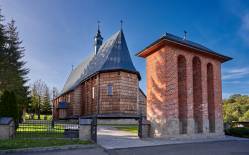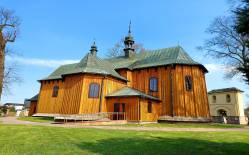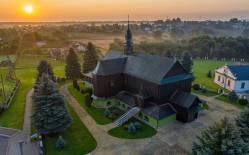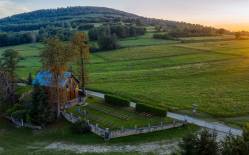The wooden church of St. Adalbert dating from the 15th century, was built on the other side of the Wisłok river at the so-called Przedmieście Górne, at a location where according to a legend St. Adalbert rested during his journey from Hungary to Prussia. The first reference to the church dates from 1448. It was consecrated in 1460, and its patrons were Saints George, Adalbert, Valentine, Ten Thousand Martyrs, and Saints Margaret, Helen and Sophia. From 1968 it was used by the faithful as a parish church of St. Adalbert.
The church lost its original Gothic character as a result of a number of alterations and reconstructions. The log building comprises a chancel enclosed with semi-hexagonal walls and adjoined by a sacristy. A small vestibule is located next to the nave. The building is covered with a peaked roof, clad with sheet metal. The outer walls are covered with horizontal wood boards, which is a rarity in this region.
In the chancel and the nave there are false ceilings with casings along the walls. Below the nave there is a crypt with graves of the church founders, the Łagoński family. The high altar from the 1600s features paintings depicting the Crucifixion Group, as well as St. Stanislaus and St. Adalbert. The Baroque style side altars have unique oval shapes and are supported by angels. These were transferred here in 1785 from the town parish church in Krosno. The top part of the altar on the left contains a sculpture of St. Adalbert, which is a replica of a medieval work of art. The frontal in the altar on the right comprises a late Baroque bass-relief depicting the passing of St. Rosalia. On the walls there are a few paintings from the 1700s. Other relics here include a Gothic sculpture of St. Sophia with daughters, from the 1500s, and a late Renaissance figure of the Immaculate Virgin Mary from the 17th century. A cross from the 10th century was found here by archaeologists.
Photo: Krystian Kłysewicz
Gallery
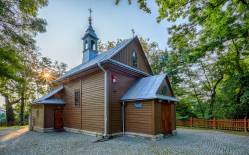
Recommended venues on the Trail



This website has been modernized with the financial support of the European Union under the Cross-Border Cooperation Programme Poland-Belarus-Ukraine 2014-2020. The responsibility for its content lies solely with the Podkarpackie Regional Tourism Board and cannot, in any case, be treated as a reflection of the position of the European Union, the Managing Authority, or the Joint Technical Secretariat of the Cross-Border Cooperation Programme Poland-Belarus-Ukraine 2014-2020.










